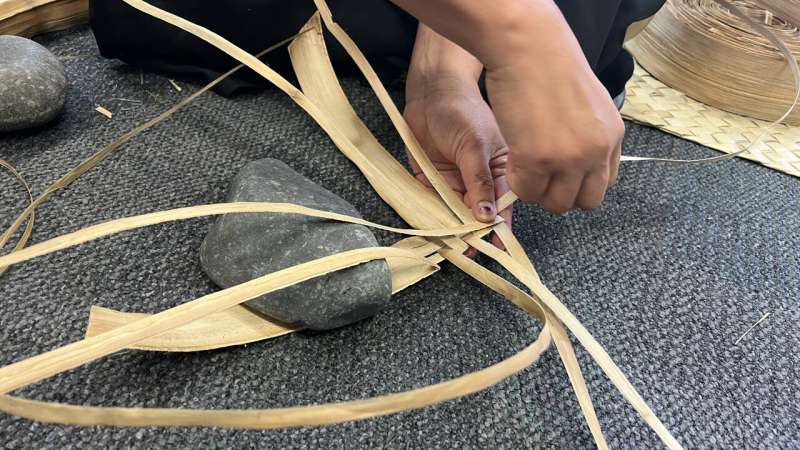This article has been reviewed according to Science X's editorial process and policies. Editors have highlighted the following attributes while ensuring the content's credibility:
fact-checked
proofread
Cross-cultural mentoring to enhance education for Samoan infants and toddlers in Aotearoa

New research led by AUT academics shows how to enhance early childhood education for Samoan pepe meamea (infants and toddlers)—the majority of whom are taught in English-medium centers.
The research points to ways of weaving key Samoan knowledge into mainstream centers to improve the well-being and sense of belonging of pepe meamea and their families.
"We want to change the way that early childhood education (ECE) discourse perpetuates European notions of infant and toddler development, giving little attention to the ways of Indigenous Pacific peoples," says Associate Professor Jacoba Matapo, co-author of the research with Senior Lecturer Tafili Utumapu-McBride and AUT alumnus Salā Pafitimai Dr. Fa'asaulala Tagoilelagi-Leota.
Dr. Utumapu-McBride says, "Our study has developed a framework that offers all early childhood teachers secure foundations from which to transform their practice for the well-being and belonging of our precious pepe meamea."
The new framework evolved in partnership with Samoan cultural experts, Aoga Amata (Samoan ECEs) and their faiaoga (teachers). It was funded by the Teaching and Learning Research Initiative (TLRI).
Talanoa (cultural dialogue) over lalaga (Samoan weaving) identified Samoan concepts, which gave rise to the framework's five ma'a tatāo (securing rocks):
- Tofāmanino (Samoan philosophies of existence). Teachers can foster this through allowing intergenerational storytelling within the family, as well as through song, dance, cultural materials, and well-being practices.
- Faiva o le fa'atufugaga (mastery of skills and competencies). This involves the teaching of cultural skills, and fostering appreciation and understanding of Samoan relational ethics.
- Fa'asinomaga (birthright and connections). Teachers can support this through the sharing of ancestral stories, honoring sibling relationships, and integrating the child's connection to cultural rights, and family and village heritage into children's learning and assessment.
- Agatausili (conduct). This emphasizes the cultural values of alofa (love), tautua (service to others) and fa'aaloalo (respect). This means being attentive and caring, granting pepe meamea the freedom to explore and move, engage with their natural surroundings, and access to cultural resources and materials.
- Paepaega (foundation stones). Teachers should understand the context of the lived experiences of pepe meamea and their families. This includes an awareness of the political and social factors that impact the community and the center.
Aoga Amata make up only 1% of early childhood centers in Aotearoa New Zealand, and so most Samoan pepe meamea attend English-medium centers.
Salā Pafitimai Dr. Fa'asaulala Tagoilelagi-Leota says to help address the needs of these children, the researchers found that mentoring relationships could work well. They paired Aoga Amata faiaoga with mainstream teachers in a mutual exchange of knowledge and skills.
"When we weave a mat, two strips of leaf are connected using a spare strip called a fenū. In a similar way, mentors and mentees were bound together," she says. "To fenū well, neither strand dominates, and neither strand is complete without the other. Both mentor and mentee had valuable knowledge to share about pepe meamea."
Associate Professor Matapo says it is crucial for non-Samoan teachers teaching Samoan pepe meamea to grasp the intricacies of their Samoan communities, regarding cultural access and ambitions.
"We encourage teachers from all backgrounds to approach discussions about Samoan teaching methods with families and extended families with an open mind," she says.
"For instance, not all families speak the Samoan language or have access to aganu'u (knowledge of village customs and protocols). On the other hand, some families may be hesitant to freely share Indigenous knowledge and customs due to their tapu (sacred) nature."
Dr. Tafili Utumapu-McBride says one of the insights to come out of the two-year study was the cultural importance the fala pepe (baby mat).
"Traditionally, the fala pepe was woven by the mother or grandmother either before or during the mother's pregnancy, creating a connection with the baby through love. It is a teacher of the child, holding the stories of the collective," she says.
"The fala pepe binds the child to their ancestors and the land as it shifts and moves with the child's day to day experiences, encouraging their cultural well-being as Samoan."
Associate Professor Matapo says nearly half of the Pacific people living in Aotearoa are Samoan, and most of them were born here and live in Auckland.
However, only 44% of New Zealand-born Samoans are proficient in the Samoan language.
"The Samoan community in Aotearoa is growing fast, so this research is critical in ensuring that future generations are brought up with cultural well-being and belonging outside of their ancestral lands."
It was important to the researchers to develop the framework in collaboration with the Samoan community, she says.
"We express our sincere gratitude to all the early childhood centers and teachers as well as their communities, for their invaluable dedication, time, and contributions in co-designing and participating in this study. We also thank the master weavers, Samoan elders, and advisors who provided their guidance throughout the research process."
More information: Pepe meamea in the spirit of the collective: Embedding Samoan indigenous philosophy in ECE for Samoan children under two. tlri.org.nz/tlri-research/rese … ive-embedding-samoan
Provided by AUT University




















